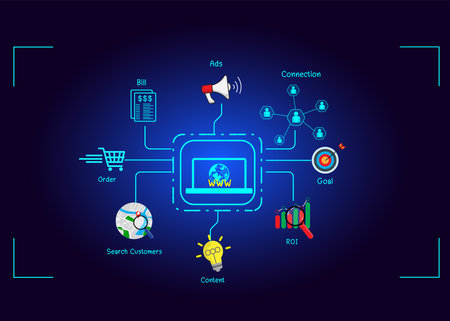1. Understanding No-Code Tools and U.S. SaaS Ecosystem
No-code tools are changing the way people build apps, websites, and workflows—especially in the United States, where businesses rely heavily on software-as-a-service (SaaS) solutions. In this section, well break down what no-code platforms are, why they matter, and how they fit into the American SaaS landscape.
What Are No-Code Tools?
No-code tools let anyone create apps, websites, and automations without writing a single line of code. These platforms use visual interfaces, drag-and-drop editors, and pre-built templates. This makes tech accessible for business owners, marketers, HR managers, or anyone who wants to solve problems fast—without hiring developers.
Popular Examples of No-Code Tools
| No-Code Tool | Main Use | Why It’s Popular in the U.S. |
|---|---|---|
| Zapier | Workflow automation | Connects thousands of SaaS apps like Gmail, Slack, QuickBooks |
| Airtable | Database + spreadsheets | User-friendly alternative to Excel/Google Sheets with app features |
| Webflow | Website building | Design and launch fully custom sites—no developer needed |
| Bubble | Web app creation | Create complex web applications visually for startups and SMBs |
| Make (formerly Integromat) | Advanced automation | Powerful workflows connecting SaaS products widely used in the U.S. |
The U.S. SaaS Ecosystem at a Glance
The American SaaS market is one of the largest in the world. Companies of every size use cloud-based tools for communication, project management, accounting, customer relationship management (CRM), and more. Some of the most popular U.S.-based SaaS products include Salesforce, Slack, Shopify, HubSpot, QuickBooks Online, Google Workspace, and Zoom.
Why Integrate No-Code With SaaS?
- Saves Time: Non-technical team members can automate repetitive tasks.
- Cuts Costs: Reduces dependency on expensive custom development.
- Makes Data Flow Easier: Connects different SaaS tools so information moves automatically where it’s needed.
- Keeps Teams Agile: Businesses can quickly adapt to new needs without waiting weeks or months for IT changes.
How No-Code Fits Into Everyday Business in the U.S.
No-code tools bridge the gap between various SaaS products that American companies already use daily. For example: a marketing manager might connect HubSpot (CRM) to Mailchimp (email marketing) using Zapier; an HR team could use Airtable to track applicants and sync data with Google Sheets automatically. These integrations help businesses run smoother and respond faster in a competitive U.S. market.
2. Key Benefits of No-Code Integration for American Businesses
Unlocking Efficiency in the U.S. Business Landscape
No-code tools have rapidly gained traction across American companies looking to streamline operations and stay ahead of the competition. By integrating these tools with popular SaaS solutions like Salesforce, QuickBooks, Shopify, or Slack, businesses are discovering practical ways to work smarter—not harder.
Major Advantages at a Glance
| Benefit | Description | U.S. Business Example |
|---|---|---|
| Efficiency Boost | Automate repetitive tasks and reduce manual errors by connecting apps without coding. | A retail store automates inventory updates between Shopify and QuickBooks, saving hours each week. |
| Cost Savings | No need to hire developers for custom integrations—business teams can set up workflows themselves. | A local marketing agency links Mailchimp with Google Sheets using no-code tools, cutting IT expenses. |
| Faster Go-to-Market | Quickly test and launch new processes or services without waiting months for development. | A startup uses Zapier to sync customer data from Facebook Ads to HubSpot in minutes, speeding up lead follow-ups. |
| Flexibility & Scalability | Easily adjust workflows as your company grows or market needs change. | An e-commerce business scales up its automated email campaigns during holiday sales with just a few clicks. |
| User Empowerment | Empower non-technical staff to build solutions, fostering innovation across teams. | HR managers use Airtable and Slack integration to automate onboarding checklists for new hires. |
Why It Matters for American Companies
The fast-paced U.S. market demands agility. No-code integration allows businesses of all sizes—from Main Street shops to nationwide enterprises—to respond quickly to new opportunities and challenges. By reducing barriers between different SaaS platforms, teams can collaborate more effectively, gain real-time insights, and deliver better customer experiences without ballooning budgets or timelines.
![]()
3. Popular No-Code Tools and Top U.S. SaaS Solutions
When it comes to integrating no-code tools with widely-used U.S. SaaS platforms, a few names stand out as leaders in the space. These tools empower businesses and individuals to automate workflows, manage data, and create custom solutions—all without writing a single line of code.
Leading No-Code Tools
The no-code landscape is filled with innovative platforms, but two of the most popular choices among American users are Zapier and Airtable.
Zapier
Zapier acts as a bridge between different software applications, allowing users to connect their favorite SaaS tools with simple “if this, then that” logic. It supports thousands of integrations, making automation accessible for everyone from small startups to large enterprises.
Airtable
Airtable is like a supercharged spreadsheet meets database. Its intuitive interface and flexible design let teams organize data, track projects, and collaborate in real-time—without needing technical know-how.
Top U.S. SaaS Solutions
No-code tools truly shine when paired with leading American SaaS platforms. Here are some top picks:
- Salesforce: The go-to CRM for managing customer relationships and sales pipelines.
- Slack: A workplace messaging app that keeps teams connected.
- Shopify: An e-commerce platform powering countless online stores in the U.S. and beyond.
No-Code Compatibility With Popular SaaS Platforms
The following table shows how Zapier and Airtable work with top U.S. SaaS solutions:
| No-Code Tool | Compatible SaaS Platform | Main Use Case |
|---|---|---|
| Zapier | Salesforce | Automate lead capture, sync contacts, trigger follow-up emails |
| Zapier | Slack | Send automated notifications, create channels from form submissions |
| Zapier | Shopify | Create orders from new leads, update inventory automatically |
| Airtable | Salesforce | Visualize CRM data, manage campaigns or custom objects collaboratively |
| Airtable | Slack | Share project updates directly into channels, automate reminders for tasks |
User-Friendly Integration Examples
- If someone fills out a form on your Shopify store, Zapier can instantly send an alert to your team’s Slack channel.
- You can use Airtable to organize all your Salesforce leads in one place and easily update them with drag-and-drop simplicity.
The Takeaway: Seamless Automation for Everyone
No-code tools like Zapier and Airtable make it easier than ever to connect top American SaaS products and streamline daily operations. Whether you’re looking to save time or eliminate manual work, these platforms offer user-friendly solutions that fit right into the way modern U.S. businesses operate.
4. Real-World Use Cases: Bringing No-Code and SaaS Together
How U.S. Businesses Are Solving Problems with No-Code and SaaS
No-code tools are revolutionizing the way American businesses operate by allowing people without programming experience to create custom solutions. When these tools are combined with popular SaaS (Software as a Service) platforms like Salesforce, Slack, or Shopify, organizations can solve daily challenges faster and more efficiently. Let’s look at some practical examples that show how this integration is making a difference for companies across the U.S.
Example 1: Automating Customer Support Workflows
A growing e-commerce company uses Zapier (a no-code automation tool) to connect Shopify with Zendesk, a leading customer service SaaS. Whenever a customer places an order in Shopify, Zapier automatically creates a support ticket in Zendesk if certain conditions are met—like high-value purchases or specific product categories. This helps the support team respond quickly to VIP customers without manual tracking.
Example 2: Streamlining Employee Onboarding
An HR department at a tech startup integrates Airtable (a no-code database tool) with Slack using Make (formerly Integromat). When a new hire is added to Airtable, Make sends a welcome message in the company’s Slack channel, sets up calendar invites for orientation meetings via Google Calendar, and generates access requests for key SaaS tools like G Suite and Trello—all without IT staff having to coordinate each step manually.
Onboarding Workflow Integration Table
| Step | No-Code Tool | SaaS Platform | Action Automated |
|---|---|---|---|
| 1 | Airtable | – | Add new employee info |
| 2 | Make (Integromat) | Slack | Send welcome message |
| 3 | Make (Integromat) | Google Calendar | Create meeting invites |
| 4 | Make (Integromat) | Trello / G Suite | Request account setup |
Example 3: Marketing Campaign Management Made Easy
A local marketing agency combines Webflow (a no-code website builder) with Mailchimp (a SaaS email marketing tool). The agency sets up forms on their clients’ websites using Webflow. When someone fills out a form, the information is sent directly to Mailchimp via Zapier. This triggers automated email campaigns tailored to each lead’s interests, saving the agency hours of manual list management each week.
Example 4: Sales Pipeline Tracking Without Coding Skills
An American real estate firm connects Typeform (for collecting client inquiries) to Salesforce using Workato (another no-code automation platform). Every time an inquiry is received through Typeform, Workato creates a new lead in Salesforce and sends a notification to the sales team’s Microsoft Teams channel. This ensures no potential client slips through the cracks and keeps everyone on the same page.
The Power of No-Code + SaaS in Everyday Business Life
These real-world use cases show how integrating no-code tools with popular U.S. SaaS platforms empowers organizations of all sizes to automate tasks, improve collaboration, and deliver better customer experiences—often without writing a single line of code.
5. Implementation Challenges and Best Practices
Common Barriers for U.S. Teams
Integrating no-code tools with popular SaaS solutions in the U.S. can be exciting, but teams often run into a few bumps along the way. Here are some of the most common challenges:
| Challenge | Description |
|---|---|
| Data Security & Compliance | No-code tools may handle sensitive information differently than traditional development, raising concerns about HIPAA, SOC 2, or GDPR compliance. |
| Integration Complexity | Connecting multiple SaaS platforms (like Salesforce, Slack, or QuickBooks) via no-code tools isn’t always seamless—APIs and connectors can be tricky. |
| User Adoption | Team members may resist new workflows or lack training on how to use no-code platforms effectively. |
| Scalability Issues | No-code solutions can hit performance limits as your business grows or processes become more complex. |
Best Practices for Successful Deployment
To help your team overcome these hurdles and make the most out of no-code integrations, keep these tips in mind:
- Start Small: Pilot no-code integrations with one process or department before rolling them out company-wide.
- Involve Key Stakeholders: Bring IT, legal, and end-users into planning early to address security and workflow needs up front.
- Choose Tools with Robust Support: Favor no-code platforms that offer strong customer support, documentation, and active communities (think Zapier, Airtable, or Make).
- Prioritize Training: Provide easy-to-follow tutorials or short workshops so everyone feels confident using the new tools.
- Monitor & Iterate: Set up regular check-ins to review integration performance and get user feedback for ongoing improvements.
Proven Strategies at a Glance
| Strategy | How it Helps |
|---|---|
| Create Integration Maps | Makes it easier to visualize connections between SaaS apps and spot potential issues early. |
| Leverage Pre-Built Templates | Saves time and reduces errors by starting with proven automation workflows tailored for U.S. businesses. |
| Document Everything | Keeps everyone on the same page—especially useful when onboarding new team members or scaling operations. |
Quick Tip:
If you’re unsure where to start, look for case studies from similar-sized U.S. companies who have integrated no-code tools successfully. Their lessons learned can save you lots of headaches down the road!

